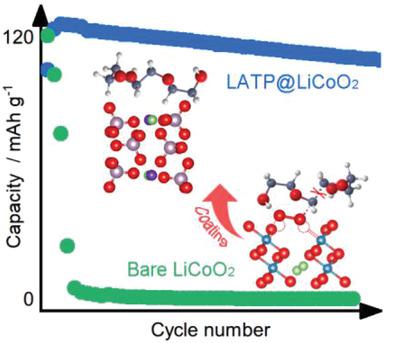当前位置:
X-MOL 学术
›
Adv. Funct. Mater.
›
论文详情
Our official English website, www.x-mol.net, welcomes your
feedback! (Note: you will need to create a separate account there.)
Enabling Stable Cycling of 4.2 V High‐Voltage All‐Solid‐State Batteries with PEO‐Based Solid Electrolyte
Advanced Functional Materials ( IF 18.5 ) Pub Date : 2020-04-06 , DOI: 10.1002/adfm.201909392 Jiliang Qiu 1, 2 , Xinyu Liu 3 , Rusong Chen 1, 2 , Qinghao Li 1, 2 , Yi Wang 1, 2 , Penghao Chen 1, 2 , Luyu Gan 1, 2 , Sang‐Jun Lee 4 , Dennis Nordlund 4 , Yijin Liu 4 , Xiqian Yu 1, 2 , Xuedong Bai 3 , Hong Li 1, 2 , Liquan Chen 1, 2
Advanced Functional Materials ( IF 18.5 ) Pub Date : 2020-04-06 , DOI: 10.1002/adfm.201909392 Jiliang Qiu 1, 2 , Xinyu Liu 3 , Rusong Chen 1, 2 , Qinghao Li 1, 2 , Yi Wang 1, 2 , Penghao Chen 1, 2 , Luyu Gan 1, 2 , Sang‐Jun Lee 4 , Dennis Nordlund 4 , Yijin Liu 4 , Xiqian Yu 1, 2 , Xuedong Bai 3 , Hong Li 1, 2 , Liquan Chen 1, 2
Affiliation

|
Poly(ethylene oxide) (PEO)‐based solid electrolytes are expected to be exploited in solid‐state batteries with high safety. Its narrow electrochemical window, however, limits the potential for high voltage and high energy density applications. Herein the electrochemical oxidation behavior of PEO and the failure mechanisms of LiCoO2‐PEO solid‐state batteries are studied. It is found that although for pure PEO it starts to oxidize at a voltage of above 3.9 V versus Li/Li+, the decomposition products have appropriate Li+ conductivity that unexpectedly form a relatively stable cathode electrolyte interphase (CEI) layer at the PEO and electrode interface. The performance degradation of the LiCoO2‐PEO battery originates from the strong oxidizing ability of LiCoO2 after delithiation at high voltages, which accelerates the decomposition of PEO and drives the self‐oxygen‐release of LiCoO2, leading to the unceasing growth of CEI and the destruction of the LiCoO2 surface. When LiCoO2 is well coated or a stable cathode LiMn0.7Fe0.3PO4 is used, a substantially improved electrochemical performance can be achieved, with 88.6% capacity retention after 50 cycles for Li1.4Al0.4Ti1.6(PO4)3 coated LiCoO2 and 90.3% capacity retention after 100 cycles for LiMn0.7Fe0.3PO4. The results suggest that, when paired with stable cathodes, the PEO‐based solid polymer electrolytes could be compatible with high voltage operation.
中文翻译:

使用基于PEO的固体电解质实现4.2 V高压全固态电池的稳定循环
基于聚环氧乙烷(PEO)的固体电解质有望在安全性高的固态电池中得到应用。然而,其狭窄的电化学窗口限制了高压和高能量密度应用的潜力。本文研究了PEO的电化学氧化行为以及LiCoO 2 -PEO固态电池的失效机理。已发现,尽管对于纯PEO,它在高于3.9 V的电压(相对于Li / Li +)处开始氧化,但分解产物具有适当的Li +电导率,意外地在PEO和PEO上形成了相对稳定的阴极电解质中间相(CEI)层。电极接口。LiCoO 2的性能下降‐PEO电池源于高压脱锂后LiCoO 2的强氧化能力,它加速了PEO的分解并驱动LiCoO 2的自氧释放,导致CEI不断增长并破坏了LiCoO 2表面。当很好地涂覆LiCoO 2或使用稳定的阴极LiMn 0.7 Fe 0.3 PO 4时,可以实现显着改善的电化学性能,Li 1.4 Al 0.4 Ti 1.6(PO 4)3涂覆的LiCoO在50次循环后的容量保持率为88.6%。2LiMn 0.7 Fe 0.3 PO 4在100次循环后的容量保持率为90.3%。结果表明,当与稳定的阴极配对时,基于PEO的固体聚合物电解质可能与高压操作兼容。
更新日期:2020-04-06
中文翻译:

使用基于PEO的固体电解质实现4.2 V高压全固态电池的稳定循环
基于聚环氧乙烷(PEO)的固体电解质有望在安全性高的固态电池中得到应用。然而,其狭窄的电化学窗口限制了高压和高能量密度应用的潜力。本文研究了PEO的电化学氧化行为以及LiCoO 2 -PEO固态电池的失效机理。已发现,尽管对于纯PEO,它在高于3.9 V的电压(相对于Li / Li +)处开始氧化,但分解产物具有适当的Li +电导率,意外地在PEO和PEO上形成了相对稳定的阴极电解质中间相(CEI)层。电极接口。LiCoO 2的性能下降‐PEO电池源于高压脱锂后LiCoO 2的强氧化能力,它加速了PEO的分解并驱动LiCoO 2的自氧释放,导致CEI不断增长并破坏了LiCoO 2表面。当很好地涂覆LiCoO 2或使用稳定的阴极LiMn 0.7 Fe 0.3 PO 4时,可以实现显着改善的电化学性能,Li 1.4 Al 0.4 Ti 1.6(PO 4)3涂覆的LiCoO在50次循环后的容量保持率为88.6%。2LiMn 0.7 Fe 0.3 PO 4在100次循环后的容量保持率为90.3%。结果表明,当与稳定的阴极配对时,基于PEO的固体聚合物电解质可能与高压操作兼容。











































 京公网安备 11010802027423号
京公网安备 11010802027423号